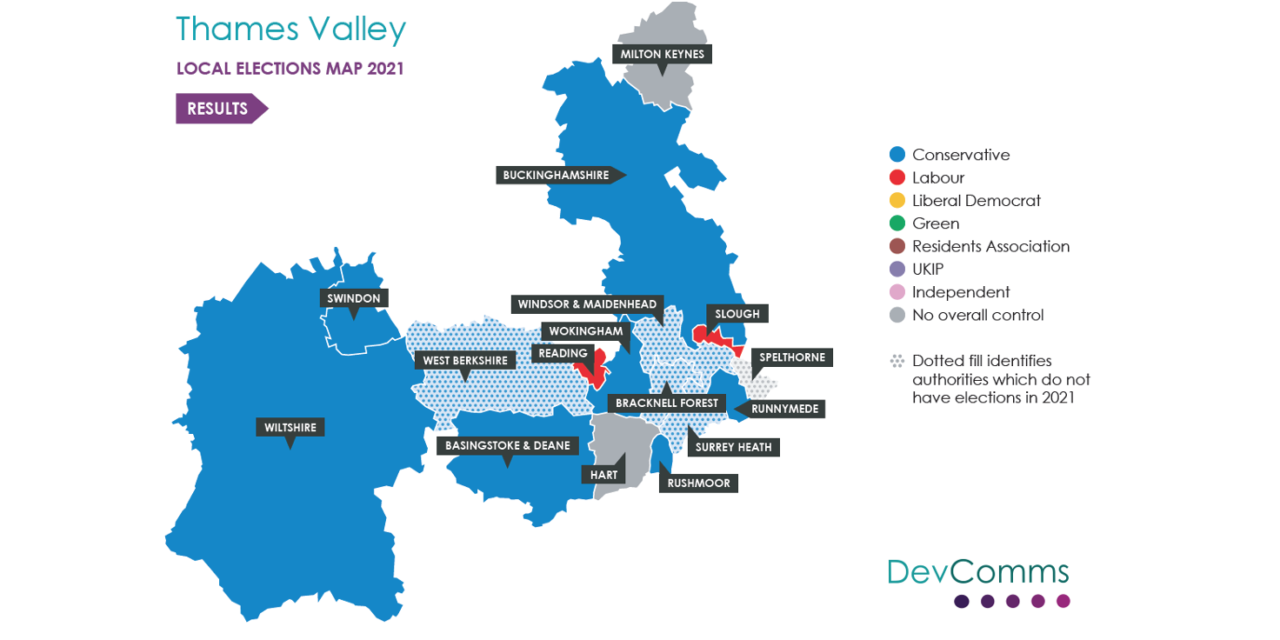DevComms director Maria Allaway outlines the key changes last week’s elections brought to the Thames Valley – and offers a new visual tool to observe the evolving political landscape.
Last week’s elections have yielded no huge surprises across the Thames Valley’s local authorities.
Across Buckinghamshire, Berkshire and parts of Hampshire and Surrey we have seen the Conservatives win the most seats while Labour suffered the biggest losses. However, we have also observed an emerging pattern seen in previous election cycles which is independents making the most net gains.
The Conservatives have held on to political control of all their authorities but have gained control of Buckinghamshire Council in its inaugural election – technically the Conservatives already had control of the council following the merger of the four districts and the county council last April but now it is official!
The Liberal Democrats held on to their Aylesbury wards and Labour and the independents held on to their seats in Wycombe and Buckingham, to the north.
Council Leader, Cllr Martin Tett, retained his seat but it remains to be seen whether a leadership challenge emerges ahead of the full council meeting later this month.
The Conservatives also won Basingstoke and Deane from no overall control – the only authority to see a change in political control in the region with Labour losing a total of eight seats on the council. The independents made the biggest gains with six seats. Conservative councillor and leader of Basingstoke and Deane, Ken Rhatigan, retained his seat.
Surrey County Council’s results bucked the trend for the Conservatives in the Thames Valley as they lost 14 seats on the council – the party’s biggest loss in the region. Whilst still in control of the council, the Conservatives now lead with a reduced majority. The Lib Dems, independents and residents’ association candidates made the biggest gains.
In Wiltshire the Conservatives lost seven seats but still maintain a comfortable majority – the Independents won seven seats whilst Labour lost four and the Lib Dems lost two. Council leader Philip Whitehead announced that despite retaining his seat, he will not seek re-election as Leader of the Council.
Eighteen seats were contested in Wokingham with the Conservatives defending 14 of them. The Conservatives managed to hold onto 11 wards while also winning one seat from Labour. The overall political make-up of the council has not changed drastically with the Conservatives remaining in control.
The biggest casualty from the election was the Labour leader, Cllr Andy Croy, who lost his seat to the Conservatives in Bulmershe & Whitegates. The leaders of the Conservative group and Lib Dems both retained their seats.
In Reading, Labour comfortably held on to control of the council but didn’t win any additional seats. The Green Party made one gain by a wafer-thin majority of 10 votes over the Labour candidate in Redlands ward where Labour member, Cllr Tony Jones, stood down after 30 years as a councillor.
Elsewhere in Berkshire, Labour maintained control of Slough, securing 11 of the 14 seats up for election on the council. Not a great surprise given that both councils are considered Labour’s strongholds in the Thames Valley.
We will look at Oxfordshire in an election update, covering The Oxford – Cambridge Arc, next week.
Interactive map
Take a look at our ‘slider’ map which shows that predominantly there were no significant changes in political control following the 2021 local elections, with the exception of Basingstoke and Deane which was a Conservative gain from no overall control.
Drag the slider feature across the map to show the before and after picture.
https://consultwithyou.co.uk/consultwithyou/elections
© Thames Tap (powered by ukpropertyforums.com).
Sign up to receive your free weekly Thames Tap newsletter here.











